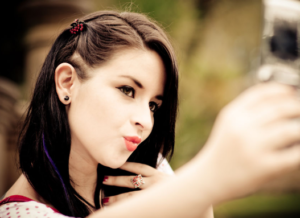Recently a Facebook “friend” (a young woman I was in a class with for a few months) posted that she had been deemed “ugly” by an app that purports to be able to divine whether someone is “beautiful” using math.
Apparently, her “interocular distance” was too wide, and some other such nonsense.
 Well, yes, it’s nonsense—but I’m sure that mathematically, it’s true. This young woman is striking by anyone’s measure. She doesn’t look like anyone else. Her eyes are noticeably far apart. But does that make her ugly?
Well, yes, it’s nonsense—but I’m sure that mathematically, it’s true. This young woman is striking by anyone’s measure. She doesn’t look like anyone else. Her eyes are noticeably far apart. But does that make her ugly?
I was lucky to have been assigned John Berger’s Ways of Seeing as college reading. No doubt it’s terribly dated now, but at the time, it was mind-bending. Using the nineteenth-century oil painting tradition, he showed how “beauty” in many instances is actually more about power and ownership.
Real beauty isn’t perfectly symmetrical faces. It’s not female bodies molded to fit an ideal invented on a computer screen. It’s not the perfection of a Photoshopped landscape that removes all irregularity and dullness.

When I think about things I find beautiful, I know that it’s the imperfection that sets them off. Why would I find beauty in a face so generically perfect I wouldn’t be able pick her out on the street? I read somewhere that all the most successful actors have something “wrong” with their faces.
But this is the joke our modern culture is playing on us: On the one hand, we prefer imperfection. We find people attractive who have all sorts of imperfections. Sometimes the imperfection itself is what attracts people.
On the other hand, we are pressured to change our own selves to make ourselves more and more perfect, less and less interesting. Women especially, but men more often now, fuss about their faces, their butts, their ankles, their hair. In a world where we actually can change almost any aspect of our looks, people are starting to think that they should.
The problem is, perfection isn’t attractive in the literal sense of the word: humans are not attracted to perfect specimens. I read recently about an experiment that underscores this: viewer were shown two photos of the same subject. One photo was a selfie, approved by the subject; the other was an informal photo taken by a researcher. The viewers overwhelmingly choose the non-selfies as “more attractive.”

In other words, what we do to ourselves in the name of social acceptance may actually have the opposite effect. When thong underwear were all the rage, for example, a male of my acquaintance confessed to me that he found panty lines very erotic.
I was very heartened by the responses that came from my “friend’s” real friends: They were appalled, amused, outraged. One of her friends posted something like, “the male half of this species begs to differ.”
I feel like each one of us needs to consider that everyone we meet is subject to this sort of media onslaught. We need to appreciate each other’s imperfect beauties, and do it out loud. We need to appreciate the individual ways in which people make this world more beautiful, whether it’s by what they wear or what they do.
Our culture is hell-bent on making us all feel like ugly, repulsive creatures who need to submit ourselves to daily torture to pay for our sins.
I beg to differ.